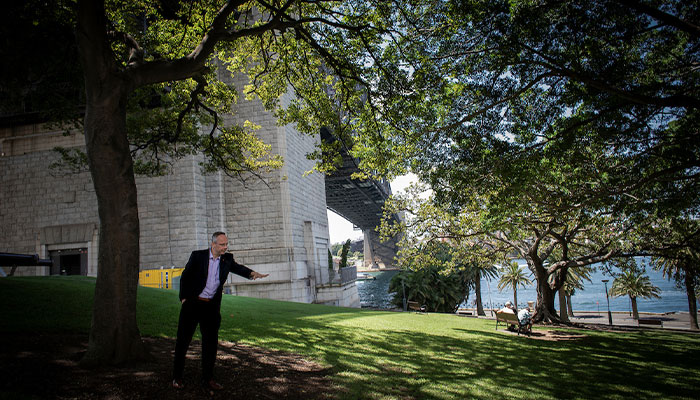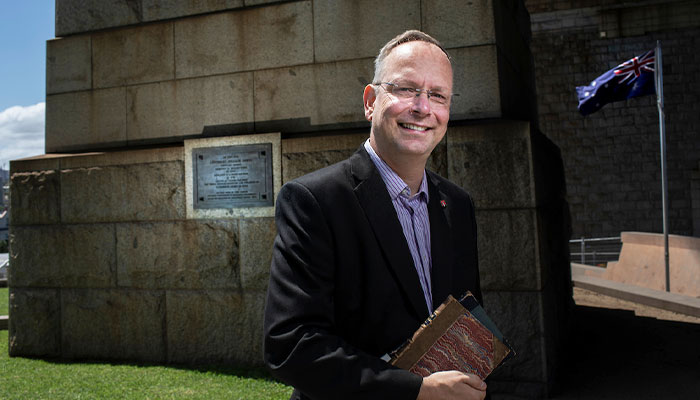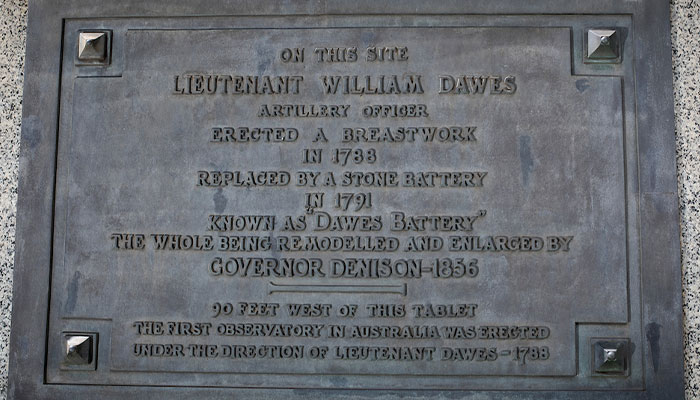After investigating maps, letters and revisiting longitude calculations from the 18th century, a Macquarie University researcher has set the historical record straight about the site of the nation's first permanent astronomical observatory.
Until now, historians were unclear where the first building was located that was used to tell local time and map the new settlement's precise position.
But astronomer Professor Richard de Grijs, from the Department of Physics and Astronomy at Macquarie University, together with Dr Andrew Jacob, curator of the Sydney Observatory, have discovered the observatory was actually first established on the bluff behind today's Park Hyatt Hotel in the Rocks, on the eastern side of the Sydney Harbour Bridge.
Unfortunately any remnants of that first observatory, established by Second Lieutenant William Dawes, an iconic figure in the founding of colonial Australia, likely disappeared when the Sydney Harbour bridge was built in the 1930s, according to de Grijs' paper published in the Journal of Astronomical History and Heritage.
The First Fleet was not just for military but also scientific purposes, which is poorly known today.
"I found photos in the State Library archives which showed that they dug so deep for the pylons and disturbed the top soil so thoroughly that they likely obliterated any trace of the observatory," says de Grijs.
"It was also built on a thin layer of sandy soil so the foundations weren't deep."
For reasons unknown today, a plaque was erected under the bridge on the sixth pylon stating incorrectly that the first observatory was located on the western side of the promontory closer to Walsh Bay.
Also, based on this misinformation, in 1995 the Sydney Cove Authority's archaeologist unsurprisingly found no trace of the original observatory at that location.
Dawes the astronomer
The story of Australia's first observatory began when the First Fleet left England in May 1787. Onboard was the young Dawes, a marine hand-picked and trained by Britain's fifth Astronomer Royal, Dr Neville Maskelyne. Dawes' brief from Maskelyne was to establish an observatory in the new colony.

Following the evidence: Professor de Grijs points out the area that he argues is the true location of William Dawes' observatory.
"The First Fleet was not just for military but also scientific purposes," says de Grijs, "which is poorly known today. Astronomers were vital on voyages of discovery, because they could cross check the readings of a chronometer – a portable timekeeping device also used for determining longitude at sea – with time measurements based on the stars."
Construction of a wooden building to replace the tent began in April 1788 on a thickly wooded, rocky promontory less than a kilometre from Sydney Cove, soon colloquially called Dawes' Point. It was completed four months later.
The observatory contained an octagonal-shaped tower with a retractable canvas pyramid roof, that Dawes would roll back to observe the night sky.
De Grijs examined Crown Plans and maps of the time to determine the observatory's location, as well as the longitude and latitude recorded by First Fleet officers and Dawes himself.
De Grijs argues that the site today is located near the Sydney Harbour bridge southern pylon, in today's Dawes Point (Tar-ra) Park and below the Dawes Battery, behind the Park Hyatt Hotel.

Written in stone: Professor de Grijs at the site of the plaque on the sixth pylon of the Sydney Harbour Bridge that incorrectly locates Australia's first astronomical observatory.
According to Dawes' correspondence with Maskelyne, the wooden observatory contained an octagonal-shaped tower on top of the bedrock with a retractable canvas pyramid roof, that Dawes would roll back to observe the night sky. In addition, it had a rectangular building at a lower level, with a staircase connecting the two.
The lieutenant also became the colony's first surveyor and unofficial meteorologist, taking readings and recording temperature and weather observations—air pressure, rainfall, wind strength and direction.
Within a year, Dawes needed bigger premises. By mid-1790, work began on a permanent observatory made of stone, a rectangular room sitting at the lower level with a staircase leading up to an eight-sided room on top of a bluff alongside a fortified battery and gunpowder magazine.
Indigenous contact
While Dawes was making scientific progress and surveying the stars and streets of the new colony, his relationship with Governor Arthur Phillip deteriorated, de Grijs says. Phillip had shown little interest in or support of the lieutenant's endeavours and at one time ordered Dawes to go on a punitive raid into an Aboriginal settlement.

Misdirection: The Harbour Bridge plaque has proved confusing, with an archaeologist in 1995 finding no trace of the observatory at the location it specifies.
But Dawes had already spent much time building rapport with the indigenous people and was working with a young Aboriginal woman to record the Gadigal language. He was the first European ever to do this. The raid went completely against his collaborative approach and his reportedly high moral principles.
He initially refused to carry out the order, which Phillip regarded as an act of insubordination. This appears to have been the last straw for Dawes and very soon afterwards, he sailed back to England with almost all his astronomical instruments.
He then abandoned astronomy and pursued a passion for the abolition of slavery, when he was appointed Governor of Sierra Leone in Africa and then Antigua in the Caribbean.
From this point, de Grijs says Dawes' observatory fell into disuse and disrepair. "No one carried on Dawes' work. The Sydney Observatory that we know today wasn't established until 1858."
The original observatory building appeared in a few maps until 1796 but then disappeared from all records.
De Grijs and Jacob are writing a biography of Dawes' life.
Richard de Grijs is Professor in the Department of Physics and Astronomy in the Faculty of Science and Engineering.






